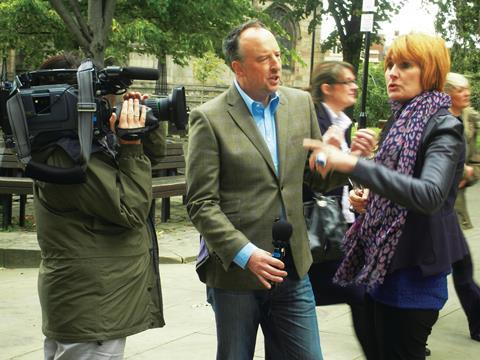Mary Portas is touring the country on her review of the high street. Tim Danaher joins her in Rotherham for an insight into her thinking

The term high street conjures up an image of a bustling thoroughfare lined with exciting stores and thronged with shoppers. But if you were expecting that from the high street in Rotherham you’d be sorely disappointed.
In its favour, it has a Primark. But even this most famed footfall driver hasn’t worked its magic here. Many of the other shops on the street are empty, some of them for many years, despite the efforts of an entrepreneurial local authority.
For the woman appointed to head the Government’s review of the UK high street, it’s a world away from her background with retailers including Harvey Nichols and her creative agency Yellowdoor.
But if Mary Portas had any illusions about the scale of the task which lies ahead of her, her visit to Rotherham will have made it clear.
The Portas review won’t be published until late November. But last week Retail Week joined the self-styled ‘Queen of Shops’ on a walk around the South Yorkshire town for an insight into her thinking so far.
Portas inspires mixed feelings in the retail community. Her last television series on Channel 4 – Mary Portas, Secret Shopper – angered many multiple retailers when she went undercover and exposed store staff alleged to be offering poor service.
Some of her remarks on multiple retailing – she tweeted ‘Quelle Horreur’ when Home Retail Group acquired the Habitat brand – have lent weight to the perception that she favours independent retailing ahead of multiples.
Yet even some who have been critics in the past have been impressed with the energy and open-mindedness with which she has approached her current assignment.
She has talked to independents, but has also met multiple retail chiefs such as Tesco UK chief executive Richard Brasher and Sainsbury’s boss Justin King for their views on the role of the high street.
It will be a relief for multiples that Portas is clear that the basis for her report will be that town centres need a healthy mix of independents and multiples to be successful.
And, while the report is still more than two months from completion, she tells Retail Week that she has put her finger on what the key themes will be.
“The big issues are planning, parking and upward-only rents,” she states emphatically.
Her challenge is to persuade multiple retailers that town centres are a better place to be than cheaper out-of-town sites with ample parking. “At the moment it’s not a level playing field; the town centre just can’t compete with the planning and the parking,” she says.
“If you’re Tesco or you’re Sainsbury’s even the rates on parking are less out of town so you can create very convenient fast retailing which is much more cost effective for you.
“So that’s a big issue, how do we get them in the town, because you need anchor brands?
“Even if you take the loveliness of Marylebone High Street, at the heart of it it’s got a supermarket and then around it you have these small independents and a real mix.”
The key to tackling the high street’s problems, Portas believes, lies in local authorities taking a proactive approach to making it easier for retailers to do business in their town centres.
“Even for these big retailers getting themselves into town is painful. They’re saying we can’t even load, we get stopped, you can’t deliver at certain times, there’s parking restrictions.
“So I believe the councils have to look at these issues.”
Councils, Portas says, will have to abandon their focus on the revenue that can be pocketed from parking and start thinking longer-term.
“The heart of it has to come from the council saying this is really important to us – this isn’t about short-term money making, but about how we can really develop town centres,” she maintains, using Rotherham as an example.
“Here there’s a commitment to making it happen and a structure and a vision of what they want; it’s not just ‘Oh let’s get lots of the same retailers in’.”
Number one priority
Rotherham’s present woes owe a lot to the planning system. It lies just three miles from Meadowhall, which is celebrating its 21st birthday this year.
In 1990 giant regional centres were all the rage, before the implementation of the ‘town centre first’ policy which has since stopped the construction of such Goliaths.
Portas is adamant that “town centre first has to be a number one priority”, but there are pressures pulling in the opposite direction in the shape of the Government’s proposed National Planning Policy Framework (NPPF), which is going through consultation at the moment and in its current form would relax the policy on out of town development.
It’s a proposal that concerns Portas. “Some of the new planning laws, the new NPPF – all these letters are doing my brain in – even that’s softened. We’ve seen all the issues this weekend in the papers about countryside and housing, but it’s softened on town centre first and we need to get that back and make that a bit tougher.
“So it may be I have to write to David Cameron before I actually write my paper, because that gets signed off on 14 October.”
Landlords and the banks are also in Portas’s sights. Some of the vacant shops in Rotherham have been empty for a decade or more and Portas wants to see the owners of the properties forced to be more proactive when it comes to finding tenants.
She also wants banks – which in many cases have become owners of secondary retail properties when the previous owners have defaulted on loans – to become more realistic when it comes to offering finance to new tenants or owners.
“I think it’s legislation that we’ll have to look at,” she says. “It will be part of my recommendations, there will be something on that. I don’t know exactly what it will be as yet.
“There are some who are being fair and this is not about knocking the landlords. But where it gets to be a real problem is where the properties are owned by banks and half of them don’t even know they’ve got it in their portfolio, and they just leave these buildings empty.
“The ones we’ve been seeing down the road – there are three properties this guy’s been buying and they’ve been derelict for 20 years and the bank’s saying you can only buy them for £250,000 if you can show us the next 15 years of leasing and renting. Who could show that in today’s climate? Everybody needs to be a bit more sensible.
“I’ve not had any conversations with the banks, but we’re going to have to.”
High street headwinds
Portas is realistic about the headwinds facing the high street and the extent to what her report, or any Government action, can do about them. “I don’t think we’ll see a high street like we’ve seen over the past 10 years. We’re over-retailed – I genuinely think there are too many similar retailers.
“People had a lot of money and enjoyed spending it and it didn’t bother them if they made mistakes. Now they’re really thinking about what they spend.”
While at pains to stress that Rotherham isn’t one of them, she is blunt about those town centres which have passed their use-by date. “The horse has bolted in some towns – not only has it bolted it’s kind of glue.”
Shops which cannot be let should be converted to residential use, Portas believes, which she says has the added benefit of adding a new resident community to a town centre.
“The two things can be really symbiotic,” she says.
It will ultimately be about creating the right sort of town centres for the catchments they serve. “In some areas, that spend will be about adding something really special to the shopping experience, and in some areas it will have to be value led – businesses like Wilkinson are really good retailers. It’s about understanding where those areas are, what they need and then creating that kind of new retailing.”
The UK high street has reinvented itself before. Portas points out that few could have foreseen the explosion of coffee shops over the past two decades. And in the multichannel age, Portas believes retailers themselves will need to play their part by creating stores that persuade people to come out of their homes and shop.
“People will shop online, we can’t get away from that, but as social beings there is actually nothing better than being out and shopping and connecting and touching. Therefore the shopkeepers have to create that experience and where it’s done best, people will go.”
What her review will be about is creating the environment where new forms of retailing and leisure can prosper. That will involve getting local and central government, landlords and the banks to do their bit to make the UK’s town centres places retailers want to trade.
But will the Government listen to Portas’s findings? She admits that while ministers have been very encouraging, she has no guarantees from the Prime Minister that her findings will be acted upon.
Shopkeepers in Rotherham and many other high streets will know that whether or not they are will be vital to them having a future as retail destinations.
Rotherham fighting back
Tuesday is market day in Rotherham and for a town that consistently vies for the dubious honour of topping the Local Data Company’s rankings of the highest levels of shop vacancies – 23.1% according to the latest survey – it feels a busy, bustling place.
Yet the signs are there that all is not well with the town’s retail mix. There are indeed a lot of empty shops and of those that are occupied there is a huge bias towards discount operators, in anything from frozen food to general merchandise.
The busiest store appears to be Perfect Home, a credit-based operation like Brighthouse. Wilkinson had long queues while Poundworld – which already has a store in the town – was gearing up to open another under its Discount UK fascia.
The overwhelming feeling is that there’s simply not much money around. That may well be because anyone who has much to spend has decamped down the road to Meadowhall.
Those people who are out are browsing market stalls with odd offers, such as second-hand magazines for £1.50. An attractive shopping arcade is largely unlet and those shops that are occupied include unusual setups such as a self-service Inland Revenue enquiry office with only a bank of phones in it.
But despite the challenges resulting from economic deprivation and Meadowhall’s presence just three miles away, Rotherham hasn’t taken things lying down. Through innovative measures such as subsidised rents and the introduction of a local loyalty card that 11,000 people and 100 retailers have signed up for, the council has persuaded entrepreneurs to open shops.

In an attractive building in the town centre Portas visited a new traditional sweet shop, an alternative fashion boutique and a charming tea room, all of which have taken advantage of the financial incentives on offer to encourage new retailers to set up.
Portas says that in the same way supermarkets and shopping centres have hands-on management, Rotherham shows town centres need it too. “We have a sophisticated infrastructure in the council that’s put town centre management in,” she says. “I don’t think you can do this without a vision and a management that leads it.”
What’s been done in Rotherham is bold, but not everyone is convinced. As my interview with Portas comes to an end, I’m stopped by four shoppers who want to tell me about their town.
“We used to have Topshop, Dorothy Perkins and Marks & Spencer. Now it’s pound shops, charity shops, and Greggs if you’re hungry,” says one. “Primark would go to Retail World [the retail park located on the edge of the town] if they could – if they took Primark out of Rotherham it’d be dead.”


























2 Readers' comments